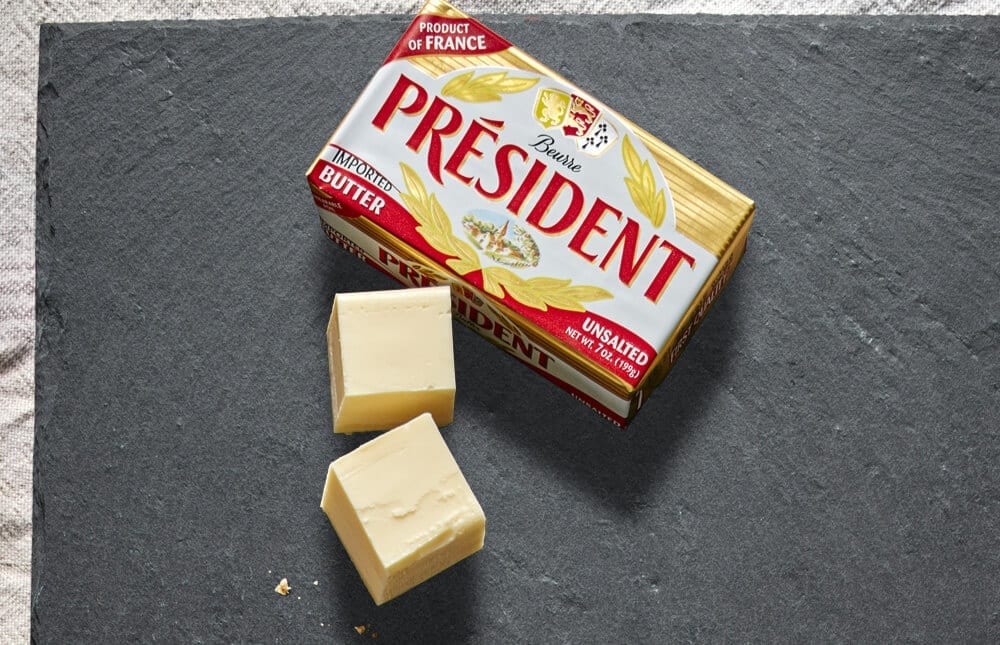
Cooking With Butter Guide
Before diving into the best way to cook with butter, it’s important to cover the butter basics. Butter is traditionally made from cow milk and has a rich flavor and creamy texture. Ranging from 80% – 82% fat, it is known for its good quality high fat content. Butter also contains essential vitamins, carbohydrates and minerals and contains a fair amount of Vitamin A, which is good for growth and good eyesight [1].
Butter comes in different forms and has different uses. Read on for how to get the most out of this culinary staple.
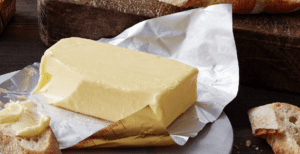
Types Of Butter & Uses
Have you ever wondered why butter is one of the most popular ingredients to cook with? It’s actually due to the high fat content. More fat simply means less water and a stronger butter taste which results in more flavor and texture. This also means more consistent results in recipes.
It’s the main reason that restaurant food tastes so delicious – restaurants cook with butter in ways that reap its benefits and elevate the flavor and richness of the dish.
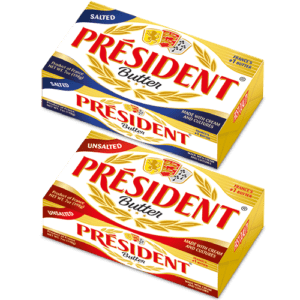
Unsalted Butter
Unsalted butter is best used for baking and cooking in order to control the salt content of the dish. This is particularly true for baking. It may not seem like a big deal, but too much salt toughens the gluten in the flour, which can throw off the recipe!
Salted Butter
Salted and sea salted butter are used as condiments and are served at the table to spread on bread or to top a dish after it’s been cooked. Make sure to let it sit out for 30 minutes or so to soften for easy spreading.
Salted butter may also be used to cook or bake as well but make sure to adjust the recipe to account for the extra salt.
Clarified Butter
Clarified butter is pure butterfat. Clarifying butter means that you remove all the milk solids and water and are left with the butterfat. This allows it to withstand higher temperatures (400-450º Fahrenheit) without turning brown/black like regular butter, clarified butter is widely used by professional chefs. Clarified butter has other benefits as well, it has fewer calories and is easy to digest for people with dairy sensitivities.
Don’t have clarified butter readily available? No problem. To make your own clarified butter, melt Président® Unsalted Butter, allowing the components to separate by density. The water evaporates, and the remainder of the milk solids sink to the bottom and are left behind when the butterfat (which would then be on top) is separated. Voilà, this separated butter fat is clarified butter.
Baking With Butter
The high fat content in butter makes it ideal for baking. Butter is also known to have high plasticity meaning it gives great lamination and puff for baking. It’s melting point is about 98.6º Fahrenheit, it becomes spreadable at room temperature (65-70º Fahrenheit), and the maximum heat that it can withstand before burning is between 300-350º Fahrenheit. The type of cooking you’re doing can also influence which butter you use and how it works best. Knowing how butter reacts at various temperatures will take your cooking to the next level.
Temperature Guide For Salted and Unsalted Butter |
|
| Spreadable | 65-70º Fahrenheit |
| Melted | 98.6º Fahrenheit |
| Smoke Point | 300-350º Fahrenheit |
Crumbly And Fluffy
If you’re baking things like cakes and muffins, make sure to use unsalted butter and soften it at room temperature ahead of time. This will make the butter easier to incorporate into the mixture and will make the final product nice and fluffy, like in this blueberry muffin recipe. A good rule of thumb is to only melt butter if the recipe specifies it. Otherwise, melting butter unnecessarily will result in a chewy baked good, like a dense cookie, because it stops the sugar crystals from slicing through the fat in butter. However, if a chewy texture is what you prefer, melt away!
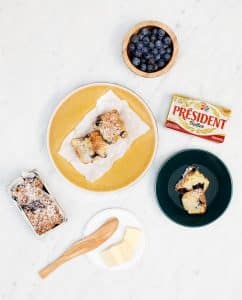
Pastries and Omelets
Cold butter is best for pastries and omelets. Use cold butter to achieve an airy, flaky texture – the pieces of butter in the dough create air pockets when baking. When making eggs, try whisking pieces of cold butter in the egg before cooking. The butter keeps the egg protein from creating too tight of a bond which results in a velvety soft omelet. Take your dessert tray to another level with these indulgent peanut butter cookies stuffed with honey buttercream, showcasing the rich decadence of France’s favorite butter.
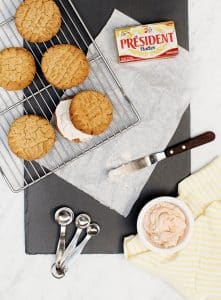
Baking With Unsalted Butter |
||
| Temperature of Butter | Cooking Result | Type of Recipe |
| Cold Butter | Airy & Flakey | Pastries & Omelets |
| Softened or Creamed Butter | Fluffy & Crumbly | Cakes & Muffins |
| Melted Butter | Chewy & Dense | Chewy Cookies |
Cooking With Butter
Proteins and Veggies
Do you ever wonder how restaurants achieve that beautiful golden-brown color in every dish? Look no further, we’ve got the answer right here. Butter is a delicious and easy way to elevate the flavors in veggies and proteins. Since butter has one of the lowest smoke points compared to other fats, it stays in the pan longer and can act as a cooking agent, allowing food to cook evenly and develop a subtle caramelization with a nutty and rich flavor.
Unlike oil, any excess butter will burn off. To make your butter last longer in the cooking process, there is a trick to keep up your sleeve so the next time you roast or sauté your proteins and veggies, your butter won’t burn.
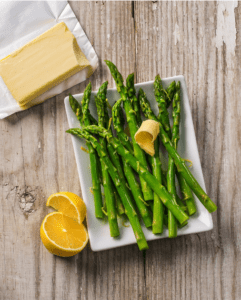
To prevent your butter from burning quickly, hold off on basting your veggies and proteins until they’re almost done cooking. This way, you reap in all the nutty, rich, buttery flavor.
Grilling with Butter
For those grill aficionados, butter is a great way to enhance the flavors of grilled proteins and veggies. To incorporate the butter in the grilling process, use clarified butter and cook on a lower heat. Baste the butter on the side that isn’t being grilled to lock in the flavors before flipping. Clarified butter will quickly char if exposed to high heat, grill between 250º-400º Fahrenheit to keep the butter in that ideal smoking phase. To avoid charring, add the clarified butter about 10º from the target temperature.
Butter is a great way to enhance the flavors and textures in any dish. For more butter inspired recipes, check out our recipe page.
References:
[1] Office of Dietary Supplements – Vitamin A. (2020, February 14). Retrieved June 15, 2020, from https://ods.od.nih.gov/factsheets/VitaminA-HealthProfessional/
